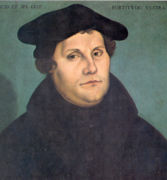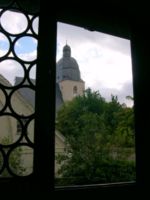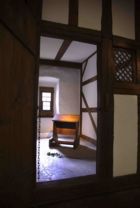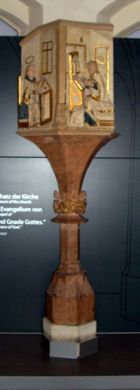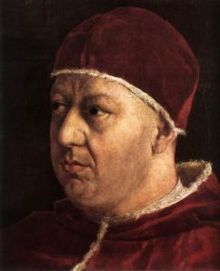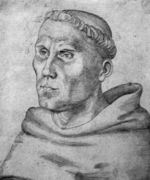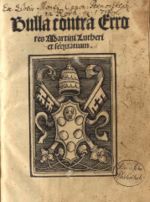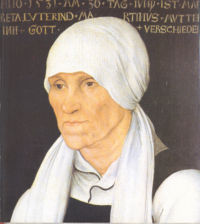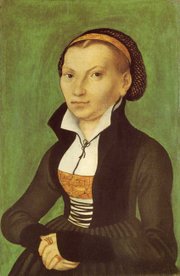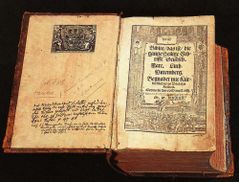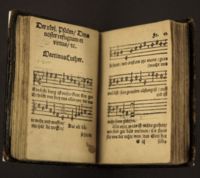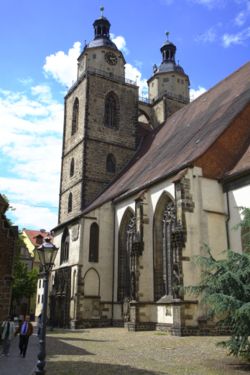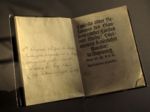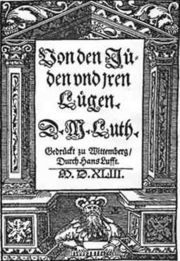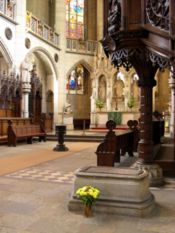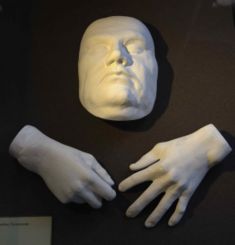Martin Luther
2007 Schools Wikipedia Selection. Related subjects: Religious figures and leaders
|
||||||||
Martin Luther ( November 10, 1483 – February 18, 1546) was a German monk, priest, professor, theologian, and church reformer. His teachings inspired the Reformation and deeply influenced the doctrines and culture of the Lutheran and Protestant traditions, as well as the course of Western civilization.
Martin Luther's life and work are closely tied to the closing of the Middle Ages and the beginning of the Modern Era in the West. His translation of the Bible furthered the development of a standard version of the German language and added several principles to the art of translation. His translation significantly influenced the English King James Version of the Bible. Due to the recently developed printing press, his writings were widely read, influencing many subsequent Reformers and thinkers, giving rise to diversifying Protestant traditions in Europe and elsewhere. Luther's hymns, including his best-known " A Mighty Fortress is Our God", inspired the development of congregational singing within Christianity. His marriage on June 13, 1525, to Katharina von Bora reintroduced the practice of clerical marriage within many Christian traditions. Today, nearly seventy million Christians belong to Lutheran churches worldwide, with some four hundred million Protestant Christians tracing their history back to Luther's reforming work.
Luther is also known for his writings about the Jews, the nature and consequences of which are the subject of much debate among scholars, many of whom have characterized them as anti-Semitic. His statements that Jews' homes should be destroyed, their synagogues and schools burned, money confiscated, and rights and liberties curtailed were revived and given widespread publicity by the Nazis in Germany in 1933–45. As a result of this, coupled with his revolutionary theological views, his legacy remains controversial.
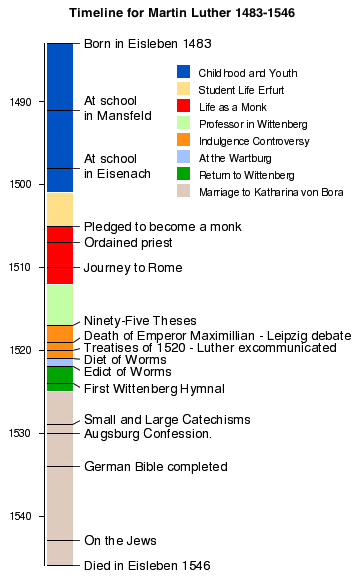 |
Early life
Luther was born to Hans and Margarethe Luther (Ziegler), on November 10, 1483, in Eisleben, Germany. He was baptized the next morning, on the feast day of St. Martin of Tours. His family moved to Mansfeld in 1484, where his father operated copper mines. Hans Luther was determined to see his eldest son become a lawyer. He sent his son Martin to schools in Mansfeld and in 1497, Magdeburg. Martin attended a school there operated by a lay group called the Brethren of the Common Life. In 1498, he attended school in Eisenach.
In 1501, at the age of seventeen, he entered the University of Erfurt where he played the lute and was nicknamed "the philosopher." He received a B.A. in 1502 and an M.A. in 1505, placing second out of seventeen candidates. In accordance with his father's wishes, Luther enrolled in the law school at the same university.
According to Luther, the course of his life changed during a thunderstorm in the summer of 1505. A lightning bolt struck near him as he was returning to school. Terrified, he cried out, "Help! Saint Anna, I'll become a monk!" He left law school, sold his books, and entered the Augustinian monastery in Erfurt on July 17, 1505.
Monastic and academic life
Luther dedicated himself to monastic life. He devoted himself to fasts, long hours in prayer and pilgrimage, and constant confession. Luther tried to please God through this dedication; instead however, it increased his awareness of his own sinfulness. He would later remark, "If anyone could have gained heaven as a monk, then I would indeed have been among them." Luther described this period of his life as one of deep spiritual despair. He said, "I lost hold of Christ the Savior and Comforter and made of him a stock-master and hangman over my poor soul."
Johann von Staupitz, Luther's superior, concluded that the young monk needed more work to distract him from excessive rumination and ordered Luther to pursue an academic career. In 1507 he was ordained to the priesthood, and in 1508 he began teaching theology at the University of Wittenberg. He received a Bachelor's degree in biblical studies on March 9, 1508, and another Bachelor's degree in the Sentences by Peter Lombard in 1509. On October 19, 1512, he was awarded his Doctor of Theology and, on October 21, 1512, was received into the senate of the theological faculty of the University of Wittenberg, having been called to the position of Doctor in Bible. He spent the rest of his career in this position at the University of Wittenberg.
Justification by faith
From 1510 to 1520, Luther lectured on the Psalms, the books of Hebrews, Romans and Galatians. As he studied these portions of the Bible, he came to understand terms such as penance and righteousness in new ways. He began to teach that salvation is a gift of God's grace through Christ received by faith alone. The first and chief article is this, Luther wrote, "Jesus Christ, our God and Lord, died for our sins and was raised again for our justification… herefore, it is clear and certain that this faith alone justifies us… Nothing of this article can be yielded or surrendered, even though heaven and earth and everything else falls."
Another essential aspect of his theology was his emphasis on the "proper distinction" between Law and Gospel. He believed that this principle of interpretation was an essential starting point in the study of the scriptures and that failing to distinguish properly between Law and Gospel was at the root of many fundamental theological errors.
The 95 Theses
On 31 October 1517 Luther wrote to Albert, Archbishop of Mainz and Magdeburg, protesting the sale of indulgences in his episcopal territories and inviting him to a disputation on the matter. He enclosed the 95 Theses, a copy of which, according to tradition, he posted the same day on the door of the Castle Church in Wittenberg.
Luther had already preached against indulgences, but he wrote the 95 Theses partly in reaction to the promotion of indulgences by Johann Tetzel, papal commissioner for indulgences in Germany, to raise funds for the renovation of St. Peter's Basilica in Rome. In thesis 28 Luther objected to a saying attributed to Tetzel: "As soon as the coin in the coffer rings, the soul from purgatory springs". The 95 Theses not only denounced such transactions as worldly but denied the pope's right to grant pardons on God's behalf in the first place: the only thing indulgences guaranteed, Luther said, was an increase in profit and greed, because the pardon of the Church was in God's power alone.
While Luther did not deny the pope’s right to grant pardons for penance imposed by the Church, he made it clear that preachers who claimed indulgences absolved buyers from all punishments and granted them salvation were in error. The final two theses exhorted Christians not to slacken in following Christ, but to be confident of entering heaven through many tribulations rather than through an assurance of peace.
Others had attacked abuses in the Church, but Luther's approach unleashed a doctrinal revolution in the reform movement. By rejecting papal and ecclesiastical practices that Luther deemed were in conflict with Scripture, he asserted the primacy of scriptural authority over the Church; and by dismissing the scriptural mandate for papal authority, the power of the keys ( Matt:16:18–19), “which he [the Pope] does not possess”, he took, possibly unintentionally, a step towards the break with Rome.
The 95 Theses were quickly translated into German, printed, and widely copied, making the controversy one of the first in history to be fanned by the printing press. Within two weeks, the theses had spread throughout Germany; within two months throughout Europe. In contrast, the response of the papacy was painstakingly slow.
Response of the papacy
Archbishop of Mainz and Magdeburg, Albert, who with the pope’s consent was using part of the indulgence income to pay his bribery debts, did not reply to Luther’s letter; instead, he had the theses checked for heresy and forwarded to Rome.
But heretics and reformers were nothing new to Leo X, whose brother’s government had once been ousted from Florence in thrall to the rebel monk Savonarola, and he responded over the next three years, “with great care as is proper”, by deploying a series of papal theologians and envoys against Luther. Perhaps he hoped the matter would die down of its own accord, because in 1518 he dismissed Luther as "a drunken German" who "when sober will change his mind".
That year, the Dominican theologian Sylvester Mazzolini wrote a refutation of Luther’s theses as heretical; and the subsequent controversy served only to enlarge Luther's doctrinal assault on the papacy. Leo summoned Luther to Rome; but the Elector Frederick persuaded him to accept a submission from Luther at Augsburg instead, where cardinal legate Cajetan, in October 1518, was obliged to listen to an unrepentant Luther inform him that the papacy was not in fact part of the original and immutable essence of the Church. Luther appealed first “from the pope not well informed to the pope who should be better informed” and then, in November, to a general council.
The Saxon papal nuncio Karl von Miltitz fared better, winning concessions from Luther at Altenburg in January 1519 and a promise to remain silent as long as his opponents did. One opponent, however, was the theologian Johann Eck, who clashed with Luther later that year in a debate at Leipzig ( June 27 – July 18, 1519) during which Luther insisted that the power of the keys belonged not to popes but to the whole Church, defined as the congregation of the faithful. Eck afterwards called Luther "the Saxon Hus" and from that moment devoted himself to his downfall.
Widening breach
The disputation at Leipzig (1519) brought Luther into contact with the humanists, particularly Melanchthon, Reuchlin and Erasmus. Luther's writings circulated widely, soon reaching France, England, and Italy as early as 1519. Students thronged to Wittenberg to hear Luther. He published a short commentary on Galatians and his Work on the Psalms. At the same time, he received deputations from Italy and from the Utraquists of Bohemia. Ulrich von Hutten and knight Franz von Sickingen offered to place Luther under their protection.
This period of Luther's life was unparalleled in his career both by way of creativity and productivity. Three of Luther's best known works were published in 1520: To the Christian Nobility of the German Nation, Prelude on the Babylonian Captivity of the Church and Freedom of a Christian.
Luther issued his To the Christian Nobility of the German Nation in August of 1520. In this work, he urged the laity, as members of the priesthood of all believers to reform the church. In this work, Luther first refers to the Pope as the Antichrist.
Luther redefined the term sacrament in his work, Prelude on the Babylonian Captivity of the Church. For Luther, a sacrament was a Means of Grace instituted by Christ Himself and made up of a visible element combined with the Word of God. Luther concluded that only Baptism and the Lord's Supper could be called sacraments by this definition at that even these sacraments were "taken captivity" by the Pope through doctrines such as the sacrifice of the Mass and withholding the cup in the Lord's Supper.
In his devotional work, On the Freedom of a Christian Luther's theology of grace is stated fully for the first time. "A Christian is perfectly free, subject to none" and "A Christian is the most dutiful slave, subject to all." Luther argued that Christians are fully redeemed by God's grace. When they act according to God's will, they are bound by no law. Yet as God's children, they are compelled to spend their whole lives in service of God and their neighbors.
Excommunication and Diet of Worms
On June 15, 1520, the Pope warned Martin Luther with the papal bull Exsurge Domine that he risked excommunication unless he recanted 41 sentences drawn from his writings within 60 days. On July 10, Luther responded:
As for me, the die is cast; I despise alike the favour and fury of Rome; I do not wish to be reconciled with her; or even to hold any communication with her. Let her condemn and burn my books; I, in turn, unless I can find no fire, will condemn and publicly burn the whole pontifical law, that swamp of heresies.
That autumn, Johann Eck proclaimed the bull in Meißen and other towns. Miltitz attempted to broker a solution; but Luther, who sent the pope a copy of On the Freedom of a Christian in October, publicly set fire to the bull and decretals at Wittenberg on December 10, 1520, an act he defended in Why the Pope and his Recent Book are Burned and Assertions Concerning All Articles. Luther was finally excommunicated by Leo X on January 3, 1521, in the bull Decet Romanum Pontificem.
Enforcement of the ban now fell to the secular authorities. Luther duly appeared on April 17, 1521, before the Diet of Worms, which Emperor Charles V had opened on January 22. Johann Eck, speaking on behalf of the empire as assistant of the Archbishop of Trier, presented Luther with a table filled with copies of his writings and asked him if the books were his and if he still believed in what they taught. Luther requested time to think about his answer, which was granted. Luther prayed, consulted with friends and mediators and gave his response to the diet the next day. Eck asked him once more would he repudiate, in whole or in part, the words he had written. Luther replied that his criticism of the abuses of, and in, the Church was, thanks to common knowledge of these abuses, fully justified.
The Emperor cut him off with an explosive, "NO!" To which Luther sharply replied that should he recant at this point he would surely open the door to even more tyranny and impiety.
Speaking for the Church, Eck, in Latin, now spoke:
"Your plea to be heard from Scripture is the one always made by heretics...How can you assume you are the only one who can understand the sense of Scripture? Would you put your judgement above that of so many famous men and claim that you know more than all of them?...to call into question the most holy orthodox, instituted by Christ the perfect Lawgiver...and which we are forbidden by the Pope and by the Emperor to discuss, least there be no end of debate? I ask you, Martin -- answer candidly and without distinctions -- do you or do you not repudiate your books and the errors which they contain?
To which Luther replied in German:
"Since your Majesty and lordships desire a simple reply, I shall answer without distinctions....Unless I shall be convinced by the testimonies of the Scriptures or by clear reason (I do not accept the authority of popes and councils, for they have contradicted each other) my conscience is captive to the Word of God. I neither can nor will make any retraction, since it is neither safe nor honourable to act against conscience. God help me. Amen."
Over the next days, private conferences were held to determine the fate of Luther, who left Worms on 26 April. The emperor presented the final draft of the Edict of Worms on May 25, 1521, declaring Martin Luther an outlaw, banning his literature, and requiring his arrest: "We want him to be apprehended and punished as a notorious heretic".
Exile at the Wartburg Castle
Luther was protected on his return journey to Wittenberg by the safe-conduct secured in advance of the diet by Frederick the Wise, who, careful to avoid openly protecting Luther, now arranged for him to be taken into safe custody on his way home by a company of masked horsemen and carried to Wartburg Castle at Eisenach, where he stayed for about a year. He grew a wide, flaring beard, took on the garb of a knight, and assumed the pseudonym Junker Jörg (Nobleman George).
His time at the Wartburg was a very productive period in his career. During this period of exile, Luther translated the New Testament from Greek into German. It was printed in September 1522. He issued an essay on the practice of Confession Concerning Confession, in which he rejected laws by the church, forcing people to go to private confession, although he affirmed the value of private confession and absolution. He wrote a polemic against Archbishop Albert of Mainz for attempting to continue the sale of indulgences, bringing such pressure against him that he stopped the sale. In a polemical treatise against Jacobus Latomus, Luther discussed the relationship between the law and grace in Christ emphasizing that the sinner receives God's grace as a gift and it is God's grace, not some indwelling quality in man, that results in the sinner's salvation. He also discussed the reality of sin in the life of the baptized Christian, and how God's grace in Christ is the constant need of every person.
Although his stay at Wartburg kept him hidden from public view, Luther often received letters from his friends and allies asking for his views and advice. For example, Philipp Melanchthon wrote to him and asked how to answer the charge that the reformers neglected pilgrimages, fasts and other traditional forms of piety. Luther replied on August 1, 1521: "If you are a preacher of mercy, do not preach an imaginary but the true mercy. If the mercy is true, you must therefore bear the true, not an imaginary sin. God does not save those who are only imaginary sinners. Be a sinner, and let your sins be strong, but let your trust in Christ be stronger, and rejoice in Christ who is the victor over sin, death, and the world. We will commit sins while we are here, for this life is not a place where justice resides. We, however, says Peter ( 2 Pet 3:13) are looking forward to a new heaven and a new earth where justice will reign."
Meanwhile, some of the Saxon clergy, notably Bartholomäus Bernhardi of Feldkirchen, had renounced the vow of celibacy. Others, including Melanchthon, had assailed the validity of monastic vows. Luther wrote Concerning Monastic Vows, at the Wartburg Castle. Though more cautious than others at this point, Luther concurred, on the ground that the vows were generally taken for the purpose of receiving salvation as a result of a monastic life. With the approval of Luther in his Concerning the Abrogation of the Private Mass, but against the firm opposition of their Prior, the Wittenberg Augustinians began changing their worship practices at the Augustinian cloister. They did away with many elements of the Mass. Their violence and intolerance, however, were displeasing to Luther, and early in December he spent a few days among them. Returning to the Wartburg, he wrote his A Sincere Admonition by Martin Luther to All Christians to Guard Against Insurrection and Rebellion. In Wittenberg, Andreas Karlstadt and the ex-Augustinian Gabriel Zwilling demanded the abolition of the private mass, communion in both kinds, the removal of pictures from churches, and the abrogation of the magistracy, and the destruction of what they considered to be idolatrous images in the form of statuary and other works of art.
Return to Wittenberg
Around Christmas 1521 Anabaptists from Zwickau added to the anarchy. Thoroughly opposed to such radical views and fearful of their results, Luther secretly returned to Wittenberg on March 6, 1522, and the Zwickau prophets left the city. For eight days beginning on March 9, Invocavit Sunday, and concluding on the following Sunday, Luther preached eight sermons that would become known as the Invocavit Sermons. In these sermons Luther counseled careful reform that took into consideration the consciences of those who were not yet persuaded to embrace reform. Communion in one kind (the consecrated bread) was restored for a time, the consecrated cup given only to those of the laity who desired it. He was thought by his hearers John Agricola and Jerome Schurf to have accomplished his goal of quelling unrest. The canon of the mass, giving it its sacrificial character, was now omitted. Since the former practice of penance had been abolished, communicants were now required to declare their intention to commune and to seek consolation in Christian confession and absolution. This new form of service was set forth by Luther in his Formula missæ et communionis (Form of the Mass and Communion, 1523), and in 1524 the first Wittenberg hymnal appeared with four of his own hymns. Since, however, his writings were forbidden in that part of Saxon ruled by Duke George, Luther declared, in his Temporal Authority: to What Extent It Should Be Obeyed, that the civil authority could enact no laws for the soul.
Marriage and family
On April 8, 1523, Luther wrote Wenceslaus Link: "Yesterday I received nine nuns from their captivity in the Nimbschen convent." Luther had arranged for Torgau burgher Leonhard Koppe on April 4 to assist twelve nuns to escape from Marien-thron Cistercian monastery in Nimbschen near Grimma in Ducal Saxony. He transported them out of the convent in herring barrels. Three of the nuns went to be with their relatives, leaving the nine that were brought to Wittenberg. One of them was Katharina von Bora. All of them but she were happily provided for. In May and June 1523, it was thought that she would be married to a Wittenberg University student, Jerome Paumgartner, but his family most likely prevented it. Dr. Caspar Glatz was the next prospective husband put forward, but Katharina had "neither desire nor love" for him. She made it known that she wanted to marry either Luther himself or Nicholas von Amsdorf. Luther did not feel that he was a fit husband considering his being excommunicated by the pope and outlawed by the emperor. In May or early June 1525, it became known in Luther's circle that he intended to marry Katharina. Forestalling any objections from friends against Katharina, Luther acted quickly: on the evening of Tuesday, June 13, 1525, Luther was legally married to Katharina, whom he would soon come to affectionately call "Katy". Katy moved into her husband's home, the former Augustinian monastery in Wittenberg, and they began their family: the Luthers had three boys and three girls:
- Hans, born June 7, 1526, studied law, became a court official, and died in 1575.
- Elizabeth, born December 10, 1527, died on August 3, 1528.
- Magdalena, born May 5, 1529, died in her father's arms September 20, 1542. Her death was particularly hard to bear for Luther and his wife.
- Martin, Jr., born November 9, 1531, studied theology but never had a regular pastoral call before his death in 1565.
- Paul, born January 28, 1533, became a physician. He fathered six children before his death on March 8, 1593 and the male line of the Luther family continued through him to John Ernest, ending in 1759.
- Margaretha, born December 17, 1534, married George von Kunheim of the noble, wealthy Prussian family, but died in 1570 at the age of 36. Her descendants have continued to the present time.
Peasants' War
The Peasants' War (1524–25) was in many ways a response to the preaching of Luther and others. Revolts by the peasantry had existed on a small scale since the 14th century, but many peasants mistakenly believed that Luther's attack on the Church and the hierarchy meant that the reformers would support an attack on the social hierarchy as well, because of the close ties between the secular princes and the princes of the Church that Luther condemned. Revolts that broke out in Swabia, Franconia, and Thuringia in 1524 gained support among peasants and disaffected nobles, many of whom were in debt at that period. Gaining momentum and a new leader in Thomas Münzer, the revolts turned into an all-out war, the experience of which played an important role in the founding of the Anabaptist movement. Initially, Luther seemed to many to support the peasants, condemning the oppressive practices of the nobility that had incited many of the peasants. As the war continued, and especially as atrocities at the hands of the peasants increased, the revolt became an embarrassment to Luther, who now professed forcefully to be against the revolt; since Luther relied on support and protection from the princes, he was afraid of alienating them. In Against the Murderous, Thieving Hordes of Peasants (1525), he encouraged the nobility to visit swift and bloody punishment upon the peasants. Many of the revolutionaries considered Luther's words a betrayal. Others withdrew once they realized that there was neither support from the Church nor from its main opponent. The war in Germany ended in 1525 when rebel forces were put down by the armies of the Swabian League.
Catechisms
In 1528 Luther took part in the Saxon visitation of parishes and schools to determine the quality of pastoral care and Christian education the people were receiving. Luther wrote in the preface to the Small Catechism,
Mercy! Good God! what manifold misery I beheld! The common people, especially in the villages, have no knowledge whatever of Christian doctrine, and, alas! many pastors are altogether incapable and incompetent to teach.
In response, Luther prepared the Small and Large Catechisms. They are instructional and devotional material on the Ten Commandments; the Apostles' Creed; the Lord's Prayer; Baptism; Confession and Absolution; and the Lord's Supper. The Small Catechism was supposed to be read by the people themselves, the Large Catechism by the pastors. Luther, who was modest about the publishing of his collected works, thought his catechisms were one of two works he would not be embarrassed to call his own:
Regarding [the plan] to collect my writings in volumes, I am quite cool and not at all eager about it because, roused by a Saturnian hunger, I would rather see them all devoured. For I acknowledge none of them to be really a book of mine, except perhaps the one On the Bound Will and the Catechism.
The two catechisms are still popular instructional materials among Lutherans.
Luther's German Bible
Luther translated the Bible into German to make it more accessible to the common people, a task he began alone in 1521 during his stay in the Wartburg castle, publishing The New Testament in September 1522 and, in collaboration with Johannes Bugenhagen, Justus Jonas, Caspar Creuziger, Philipp Melanchthon, Matthäus Aurogallus, and George Rörer, the whole Bible in 1534. He worked on refining the translation for the rest of his life. The Luther Bible contributed to the emergence of the modern German language and is regarded as a landmark in German literature. The 1534 edition was also profoundly influential on William Tyndale's translation, a precursor of the King James Bible.
Liturgy and Church government
Martin Luther’s German Mass of 1526 provided for weekday services and for catechetical instruction. He strongly objected, however, to making a new law of the forms and urged the retention of other good liturgies. While Luther advocated Christian liberty in liturgical matters in this way, he also spoke out in favour of maintaining and establishing liturgical uniformity among those sharing the same faith in a given area. He saw in liturgical uniformity a fitting outward expression of unity in the faith, while in liturgical variation, an indication of possible doctrinal variation. He did not consider liturgical change a virtue, especially when it might be made by individual Christians or congregations: he was content to conserve and reform what the Church had inherited from the past. Therefore Luther, while eliminating and condemning those parts of the mass indicating the Eucharist was a propitiatory sacrifice and the Body and Blood of Christ by transubstantiation, retained the use of an eastward altar, stole, chasuble and alb. However, Luther is reported to have said, that later on, more changes would have to be made to the liturgy, which during his lifetime would still have offended the faithful people.
The gradual transformation of the administration of baptism was accomplished in the Baptismal Booklet. In May, 1525, the first Evangelical ordination took place at Wittenberg. “Luther had long since rejected the Roman Catholic sacrament of ordination, and had replaced it by a simple calling to the service of preaching and the administration of the sacraments. The laying-on of hands with prayer in a solemn congregational service was considered a fitting human rite.”
To fill the vacuum of the lack of higher ecclesiastical authority — few bishops in the German lands embraced Luther’s doctrine — “as early as 1525… [Luther] held that the secular authorities should take part in the administration of the Church, [by] making appointments to ecclesiastical office and directing visitations” of clergy and churches. These tasks were not inherent powers of the “secular authorities as such, and Luther gladly would have had them vested in an evangelical episcopate” had a larger number of bishops become evangelicals. “He… declared in 1542 that the Evangelical princes themselves ‘must be necessity-bishops,’” and envisioned ecclesiastical powers being exercised in congregational meetings of Christians, "but [he] determined to be guided by the course of events and to wait until parishes and schools were provided with the proper persons." The discoveries of the Saxon visitation (1527–29) showed that parishes and schools were not ready for such responsiblity, necessitating the retention of ecclesiastical forms as they were at the beginning of the Reformation.
Melanchthon's Instruction for the Visitors of Parish Pastors, facilitated the Saxon visitation. The visitation accordingly took place in 1527–29, "Luther [wrote] the preface to Melanchthon's Unterricht der Visitatoren an die Pfarrherrn, and [acted] as a visitor in one of the districts after Oct., 1528, while, as a result of his observations, he wrote both his catechisms in 1529. At the same time he took the keenest interest in education, conferring with Georg Spalatin in 1524 on plans for a school system, and declared that it was the duty of the civil authorities to provide schools and to see that parents sent their children to them. He also advocated the establishment of elementary schools for the instruction of girls." In the meantime, Lutheran churches in Scandinavia and many of the Baltic States, as well as the Moravians, continued to maintain the Historic Episcopate and apostolic succession, even though they had adopted Luther's anti-papal theology.
Eucharist controversy
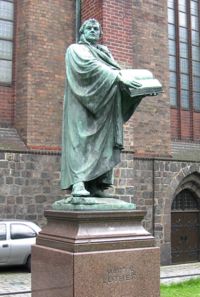
Martin Luther's views on the Eucharist, the sacrament of the Last Supper, were put to the test in October 1529 at the Marburg Colloquy, an assembly of Protestant theologians gathered by Philip I, Landgrave of Hesse, to establish doctrinal consistency in the emerging Protestant states. Agreement was achieved on most points, the exception being the nature of the Eucharist, an issue crucial to Luther.
The theologians, including Zwingli, Karlstadt, Jud, and Œcolampadius, differed among themselves on the significance of the words of institution spoken by Jesus at the Last Supper: "This is my body which is for you", "This cup is the new covenant in my blood" ( 1 Corinthians 11:23–26). Whereas Luther insisted on the Real Presence of Jesus at the Eucharist, other theologians believed God to be only symbolically present: Zwingli, for example, denied Jesus's ability to be in more than one place at a time. But Luther, who affirmed the doctrine of Hypostatic Union, that Jesus is one and the same as God, was clear:
For I do not want to deny in any way that God’s power is able to make a body be simultaneously in many places, even in a corporeal and circumscribed manner. For who wants to try to prove that God is unable to do that? Who has seen the limits of his power?
In taking the words of institution at face value, Luther saw no reason to define the mystery of the Eucharist in terms such as consubstantiation, the notion that the substance of Christ's body and blood are present alongside that of the bread and the wine, or impanation, that God was literally made bread. Although his doctrine has been described as both of those, he simply taught that the body and blood of Christ are present, essence unchanged, in, with, and under the forms of bread and wine. He used "the analogy of the iron put into the fire whereby both fire and iron are united in the red-hot iron and yet each continues unchanged", a process which he called the " Sacramental Union".
While recognising the commemorative element of "do this, as often as you drink it, in remembrance of me", Luther also took issue with Zwingli's view that the Eucharist is merely memorial. And he disagreed that the benefit of the sacrament is conditional on good works, asserting rather that it is conditional on faith alone, laying stress on the words "given for you" and therefore on the atonement and forgiveness through the death of Jesus.
Luther was convinced that God had blinded Zwingli's eyes so that he could not see the true significance of the Lord's Supper, denouncing Zwingli and his followers as "fanatics" and "devils" and refusing to call his opponents brethren, though he wished them peace and love.
Despite these disagreements on the Eucharist, the Marburg Colloquy paved the way for the signing in 1530 of the Augsburg Confession and for the formation of the Schmalkaldic League the following year by leading Protestant nobles such as Philip of Hesse, John Frederick of Saxony, and George, Margrave of Brandenburg-Ansbach. Nevertheless, interpretations of the Eucharist differ among Protestants to this day.
Augsburg Confession
| Part of a series on Lutheranism |
|
 |
|
| Luther's Seal | |
| Beginnings | |
|---|---|
|
Christianity |
|
| People | |
|
Martin Luther |
|
| Book of Concord | |
|
Augsburg Confession |
|
| Theology and Sacraments | |
|
Sacramental Union |
|
| Liturgy and Worship | |
|
Divine Service |
|
| Organizations | |
|
Lutheran World Federation |
|
Charles V, the Holy Roman Emperor, convened an Imperial Diet in Augsburg in 1530 with the goal of uniting the empire against the Ottoman Turks, who had besieged Vienna the previous autumn.
To achieve unity, Charles required a resolution of the religious controversies in his realm. Luther, despised by emperor and empire, was left behind at the Coburg fortress while his elector and colleagues from Wittenberg attended the diet. The Augsburg Confession, a summary of the Lutheran faith authored by Philipp Melanchthon but influenced by Luther, was read aloud to the emperor. It was the first specifically Lutheran confession included in the Book of Concord of 1580, and is regarded as the principal confession of the Lutheran Church.
Luther and antisemitism
In his 60,000-word pamphlet On the Jews and Their Lies, published in 1543 as Von den Juden und ihren Lügen, Luther spoke of the need to set synagogues on fire, destroy Jewish prayerbooks, forbid rabbis from preaching, seize Jews' property and money, smash and destroy their homes, and ensure that these "poisonous envenomed worms" be forced into labor or expelled "for all time." Four centuries later, a first edition of the pamphlet was given to Julius Streicher, editor of the Nazi newspaper Der Stürmer, by the city of Nuremberg in honour of his birthday in 1937. The newspaper later described the pamphlet as the most radically anti-Semitic tract ever published, a view that is shared by contemporary scholars. The German philosopher Karl Jaspers said of it: "There you already have the whole Nazi program."
British historian Paul Johnson writes that, even before On the Jews and their Lies, Luther "got the Jews expelled from Saxony in 1537, and in the 1540s he drove them from many German towns; he tried unsuccessfully to get the elector to expel them from Brandenburg in 1543. His followers continued to agitate against the Jews there: they sacked the Berlin synagogue in 1572 and the following year finally got their way, the Jews being banned from the entire country."
There is little doubt among historians that Luther's rhetoric may have contributed to, or at the very least foreshadowed, the actions of the Nazis when Adolf Hitler came to power in Germany in 1933, although the extent to which it played a direct role in the events leading to the Holocaust is debated. At the heart of the debate is whether it is anachronistic to view Luther's sentiments as an example, or early precursor, of racial anti-Semitism — hatred toward the Jews as a people — rather than anti-Judaism — contempt for Judaism as a religion.
In The World Must Know, the official publication of the United States Holocaust Memorial Museum, the museum's project director Michael Berenbaum writes that Luther's reliance on the Bible as the sole source of Christian authority fed his fury toward Jews over their rejection of Jesus as the messiah. For Luther, salvation depended on the belief that Jesus was the son of God, a belief that Jews do not share. Earlier in his life, Luther had argued that the Jews had been prevented from converting to Christianity by the proclamation of what he believed to be an impure gospel by Christians, and he believed they would respond favorably to the evangelical message if it were presented to them gently. He expressed concern for the poor conditions in which they were forced to live, and insisted that anyone denying that Jesus was born a Jew was committing heresy. Graham Noble writes that he wanted to save Jews, in his own terms, not exterminate them, but beneath his apparent reasonableness toward them, there was a "biting intolerance," which produced "ever more furious demands for their conversion to his own brand of Christianity." When they failed to convert, he turned on them. Berenbaum quotes Luther’s apparent support for the idea that Christians may be justified in killing Jews: “We are at fault in not slaying them. Rather we allow them to live freely in our midst despite their murder, cursing, blaspheming, lying and defaming.”
Scholars argue that the violence of Luther's views lent a new element to the standard Christian suspicion of Judaism. Sociologist Ronald Berger has written that Luther is credited with “Germanizing the Christian critique of Judaism and establishing anti-Semitism as a key element of German culture and national identity.” Historian Paul Rose concurs, arguing that Luther caused a “hysterical and demonizing mentality” about Jews to enter German thought and discourse, a mentality that might otherwise have been absent. The coarseness of the language made his material particularly attractive to Nazism. In Mein Kampf, Hitler named Luther as one of the great historical “protagonists” he most admired. On the Jews and Their Lies was publicly exhibited in a glass case at the Nuremberg rallies and was quoted in a 54-page explanation of the Aryan Law by Dr. E.H. Schulz and Dr. R. Frercks. The Nazi Bishop Martin Sasse of Thuringia hailed Luther as “the greatest anti-Semite of his time,” and said that it was a happy coincidence that Kristallnacht fell on Luther’s birthday.
A minority viewpoint disagrees with the attempt to link Luther's work causally to the rise of Nazi anti-Semitism, arguing that it is too simplistic an analysis. Writing in Lutheran Quarterly, Johannes Wallmann, professor of church history at the Humboldt University of Berlin, writes that Luther's writings against the Jews were largely ignored in the 18th and 19th centuries, and journalist and lay Lutheran theologian Uwe Siemon-Netto argues that it was because the Nazis were already anti-Semites that they revived Luther's work on the Jews. For Siemon-Netto, Nazism had its origins, not in Luther, but in 19th century Romanticism and 20th century Darwinism: "To suggest that Lutheran theology turned Germans into Nazis is a false charge that simply cannot be substantiated by the facts." Luther and Reformation historian Martin Brecht concurs that there is a "world of difference" between Luther's belief in salvation, which depended on a faith in Jesus being the messiah, and a racial ideology of anti-Semitism," and Graham Noble agrees that, although Luther offered a "historical and intellectual justification for the Holocaust," he had "no notion of the pseudo-scientific eugenics which underpinned Nazi anti-Semitism." Reformation historian Richard Marius writes that, far from hating the Jewish people, and despite the ferocity of his attacks, Luther "never truly renounced the notion of coexistence between Jews and Christians."
Lutheran church bodies have distanced themselves from this aspect of Luther's work. In 1983, the Lutheran Church - Missouri Synod, denounced Luther's "hostile attitude" toward the Jews. In 1994, the Church Council of the Evangelical Lutheran Church in America announced: "As did many of Luther's own companions in the sixteenth century, we reject this violent invective, and yet more do we express our deep and abiding sorrow over its tragic effects on subsequent generations."
Luther on witchcraft and magic
Luther shared the belief that witchcraft existed and was inimical to Christianity. While Luther did not specifically write about witchcraft, his ideas of it are available through discussions of Biblical references to witchcraft and in table talk. His ideas were similar to those of late medieval Christian thinkers. Luther shared some of the superstitions about witchcraft that were common in his time. When interpreting Exodus 22:18, Luther stated that witches with the help of the devil could steal milk simply by thinking of a cow.
In his Small Catechism, Luther taught that witchcraft was a sin against the second commandment and prescribed the Biblical penalty for it in a "table talk":
On 25 August 1538 there was much discussion about witches and sorceresses who steal chicken eggs out of nests, or steal milk and butter. Doctor Luther said: "One should show no mercy to these [women]; I would burn them myself, for we read in the Law that the priests were the ones to begin the stoning of criminals."
Final years
Luther's rhetoric became more severe in his final years concerning Jews and Christians alike. In the context of the opening of the Council of Trent in 1545, Luther wrote a pamphlet entitled, Against the Roman Papacy an Institution of the Devil. It was his bitterest attack against the institution of the papacy. In some of his later writings, popes, bishops, and cardinals were referred to as "Roman sodom." He once blessed a group of followers, saying: "May the Lord fill you with His blessings and with hatred of the Pope."
Luther's health declined in the years before his death. Throughout his years as a reformer, Luther had suffered from a variety of ailments, including constipation, hemorrhoids, heart congestion, fainting spells, dizziness and roaring in the ears. From 1531–1546 Luther experienced a series of more severe health problems, including ringing in the ears, and, in 1536–1537, Luther began to experience kidney and bladder stones, which caused him particular agony during the rest of his life. He also suffered from arthritis, and experienced a ruptured ear drum due to an inner ear infection. In December 1544, he suffered from severe angina and finally suffered a heart attack which led to his death in February 1546.
During the later years of his life, Luther remained busy and active, with lecturing at the university on the Biblical book of Genesis, serving as dean of the theological faculty, making many visitations to churches. During the final nine years of his life Luther wrote 165 treatises and nearly ten letters a day, examined many candidates for doctoral degrees in theology, hosting doctoral feats for the successful candidates. His later years were marked by continuing illnesses and physical problems, making him short-tempered and even more pointed and harsh in his writings and comments. His wife Katie was overheard saying, "Dear husband, you are too rude," and he responded, "They teach me to be rude."
Luther's final journey, to Mansfeld, was taken due to his concern for his siblings' families continuing in their father Hans Luther's copper mining trade. Their livelihood was threatened by Count Albrecht of Mansfeld bringing the industry under his own control. The controversy that ensued involved all four Mansfeld counts: Albrecht, Philip, John George, and Gerhard. Luther journeyed to Mansfeld twice in late 1545 to participate in the negotiations for a settlement, and a third visit was needed in early 1546 for their completion.
Accompanied by his three sons, Luther left Wittenberg on January 23. On Febuary 1st he send a tender letter to his wife:
"I wish you peace and love in Christ, and send you my poor, old, infirm love. Dear Katie, I was weak on the road to Eisleben, but that was my own fault...Such a cold wind blew from behind through my cap on my head that it was like to turn my brain to ice. This may have helped my vertigo [to get worse], but now, thank God, I am so well that I am sorely tempted by lovely women and care not how gallent I am...God bless you."
The negotiations were successfully concluded on February 17. After 8:00 p.m. that day, Luther experienced chest pains. When he went to his bed, he prayed, "Into your hand I commit my spirit; you have redeemed me, O Lord, faithful God" (Ps. 31:5), the common prayer of the dying. At 1:00 a.m. he awoke with more chest pain and was warmed with hot towels. Knowing that death was imminent, he thanked God for revealing His Son to him in Whom he had believed. His companions, Justus Jonas and Michael Coelius, shouted loudly, "Reverend father, are you ready to die trusting in your Lord Jesus Christ and to confess the doctrine which you have taught in His name?" A distinct "Yes" was Luther's reply. An apoplectic stroke deprived him of his speech, and shortly thereafter of his life. He died 2:45 a.m., February 18, 1546, aged 62, in Eisleben, the city of his birth. Luther was buried in the Castle Church in Wittenberg, beneath the pulpit.
A piece of paper was found in Luther's pocket with his last known written statement:
No one who was not a shepherd or a peasant for five years can understand Virgil in his Bucolica and Georgica. I maintain that no one can undersand Cicero in his letters unless he was active in important affairs of state for twenty years. Let no one who had not guided the congregations with the prophets for one hundred years believe that he has tasted Holy Scripture thoroughly. For this reason the miracle is stupendous (1) in John the Baptist, (2) in Christ, (3) in the Apostles. Do not try to fathom this divine Aeneid, but humbly worship its footprints. We are beggars. That is true.
